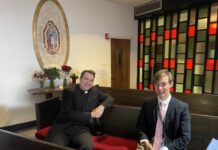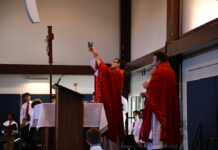Jesuit freshmen, sophomores, and juniors gather in the prayer courtyard, heads bowed in prayer, sending silent reflections to the Heavens. After introducing a new method of faith formation, Jesuit students can now visit the prayer garden during 4th, 5th, and 6th period to say a rosary led by either Mr. Knight or Mr. Ornelas.
This prayer time was engineered as “another way of prayer” according to Mr. Knight. He added that the rosary specifically is a “matter of focusing on the glorious mysteries and reflecting on them,” a simple act many Catholics probably don’t do enough. Anyone who is free during those periods is welcome to join the prayer, and Mr. Knight, along with Mr. Ornelas and campus ministry, hope many will take advantage of the “additional opportunity for prayer.”
An ancient prayer, the rosary dates back to the Middle Ages where it originated as a way for peasants and lower class citizens to count prayers using beads. During that time period, the beads were known as Paternosters, Latin for “Our Father,” and the rosary played a pivotal role in the conversion of many non-believers during the 14th and 15th centuries. Over time, the rosary began to take shape as the prayer we know today, first consisting of 50 Hail Marys, and eventually adding a reflection of the lives of Mary and Jesus. The rosary we use today was developed sometime around the 16th century, and still serves as a powerful connection to the mother of God.
Principal Mr. Garrison noted that the school has been looking for a”way to get the students more exposure to [the rosary],” and Mr. Kirby, a Jesuit administrator, believes that lunchtime is an “excellent opportunity” for this exposure.
Right outside of campus ministry, a prayer table has been set up with the intention of helping students who are unfamiliar with the rosary to pick up the beads and give it a try. The table has rosaries, booklets on how to pray the rosary, and a book of prayer intentions. If you have never prayed the rosary or maybe it has been a while, be sure to stop by the table to learn more about it.
Throughout its history, the rosary has affected the lives of countless people across the world including students and faculty members at Jesuit. Connor Thomas ’18 commented that the rosary is special to him because his rosary beads were handed down to him from his great-grandfather who wore it as he fought in World War II. He also added that they “were blessed by Pope Pius X,” increasing their spiritual value.
A sophomore counselor who helps run the prayers, Mr. Ornelas told The Roundup, “The rosary has always been in my family… and it reminds me of my youth, reminds me of my prayer life, and it reminds me of my family.”
The rosary has long been regarded as a prayer of great power and many people pray it in hopes of a miracle. Mrs. Gerber, a math teacher, shared her experience with the power of the rosary: “For the first time in forever, [she] did a full rosary, thinking of her great-grandmother-in-law,” who wasn’t doing very well. The next morning, she found out her great-grandmother-in-law had passed the previous night, but Mrs. Gerber said, “It wasn’t sad, it was peaceful,” and she contemplated how she “hadn’t done it in so long and then she says it for someone and now she’s in peace.”
The Rosary is a powerful tool for prayer, and you can never say it enough, so stop by the prayer garden during your lunch period and dive deeper into your faith.






